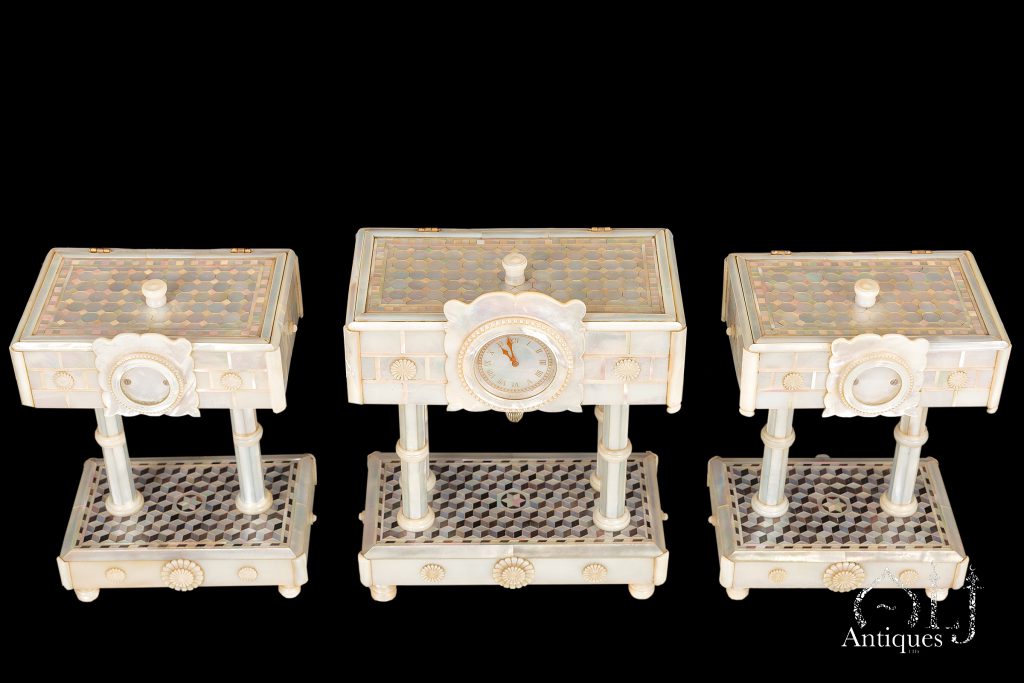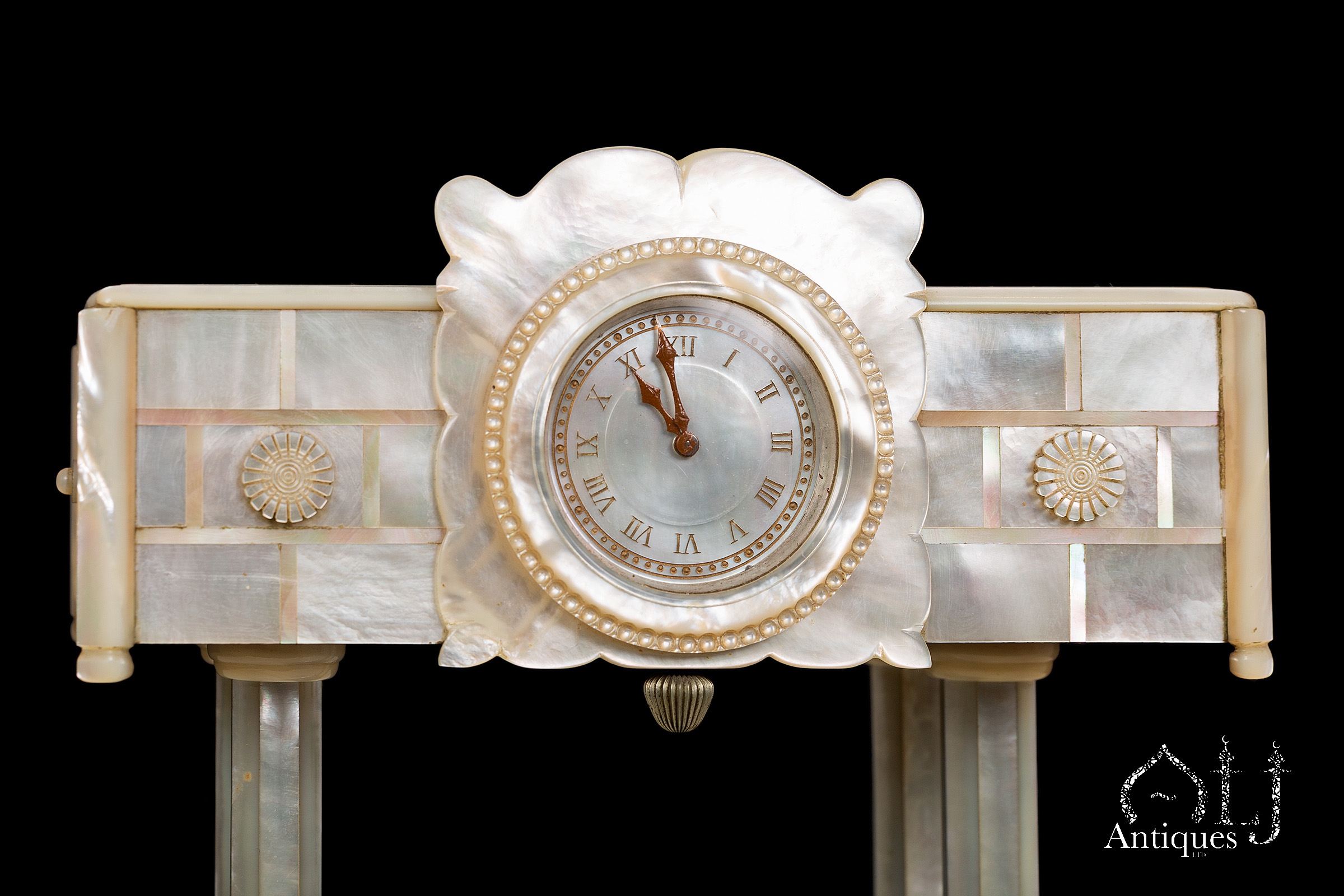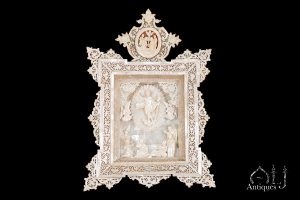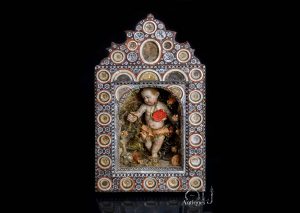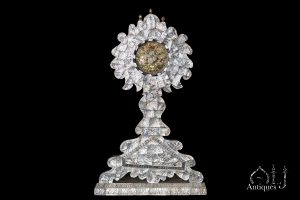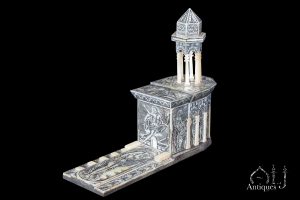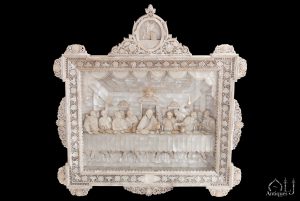Description
The shape of these models had been mainly influenced by the existing construction and memorial that had been built on top of the place where it is believed Jesus was born, in the Grotto under the Church of the Nativity in Bethlehem (كنيسة المهد -ـ–بيت لحم) ، and the other alters at the Church of the Holy Sepulchre in Jerusalem (كنيسة القيامة ـ القدس)
The models are decorated with beautiful geometrical designs.
The finely and precisely white cut mother of pearl is set in a similar manner to the masonry stonework of both the church of the Nativity and the Holy Sepulchre.
The lower and central part of each model is beautifully decorated with a geometrical round hole and six pointed star, representing the original fourteen pointed star or the radiant sun, which is made out of silver, mounted on a marble stone floor surrounding the sacred round hole at the Grotto of the Church of the Nativity where it is believed Christ was born. The star that symbolizes the birthplace of Jesus in Bethlehem can also be found in other Catholic Churches in Jerusalem and Bethlehem, represented in various types of geometric mosaic stars, all are beautifully designed and set at the chapel’s floors. Examples such as the stars at the chapels of the Calvary gospel and St. Helena at the church of the Holy Sepulchre. Another beautiful example of the mosaic star can be found at the church floor of St. Nicholas in Bayt-Jala.
The Silver Star Shaped Marker on the Holy Ground of Jesus Birth Site at the Church of the Nativity in Bethlehem.
The models are also embossed with beautifully and precisely carved mother of pearl flowers representing the flower wreaths (أكاليل الزهور) that usually got gifted, presented and laid out at the memorial.
The Silver Star Shaped Marker on the Holy Ground of Jesus Birth Site at the Church of the Nativity in Bethlehem.
The main structures of the three-garniture boxes, which were possibly intended to be used for religious purposes as reliquary containers, were made out zinc.
The locals in the holy lands conventionally had used zinc due to its recyclability feature and easy to work with.
Also the maker of these models had probably preferred to use zinc as a substitute to wood, as wood would have not be able to sustain the weight of the material used.
In order to create a contrast of colours on the zinc garniture structure, the clever artist had carefully and deliberately veneered the structure with three different shades of coloured mother of pearl. Including the purple colour of the abalone mother of pearl, this is similar to the contrast among the square shaped stone tiles at the church of the Nativity & St. Catherine in Bethlehem.
A 1920s. Swiss pocket watch of Hebdomas make with 8 days power reserve is fitted to the middle upper part of the façade of the largest model. The watch had been refitted into a finely polished mother-of-pearl case, also the watch dials were beautifully remade, engraved and painted with gold to match the mother of pearl case.
Whereas the façade of the upper part of the other two models were also refitted with detachable glazed round frames, probably also to be used as reliquary containers or as photo frames.
Also these very rare and highly refined models were clearly trying to depict the various types of Alters located at the various chapels at the Church of the Holy Sepulcher, each alter has either four or two pillared rectangular shaped architectural structure, these very distinct alters are located at the following chapels of the Church of the Holy Sepulcher in Jerusalem:-
1- The Alter at the crucifixion Calvary Gospel (الجلجثة).
2- The Alters at the prison of Christ (دير أو كنيسة سجن السيد المسيح) .
3- The Alter at the chapel of Adam (قبر ادم) .
4- The Alter at the Longinus Chapel (قائد المئة لونجينوس).
5- But in our opinion, the Altar which offers the closest resemblance in shape to our largest model is the four pillared Alter located at the chapel of the Derision (مكان لباس الارجوان) . Also it’s very important to notice the distinct two sections of the wooden pillars of the Triptych hanging on the walls of the Chapel, which is very similar to the pillars of our models.
The Chapel of the Invention of the Cross
This old photo shows the huge similarities between the compleat structure of this two pillared Alter including it’s rectangular shaped base, also the rectangular shaped base of the big Cross which is laying behind it, if compared with our two pillared Models, the big resemblance is very evident especially if the model lid is wide open.
Please notice the similarities of the two prominent circular sections at the joints of this stone column or pillar in comparison with the pillars of our models.
Further Analysis & Discussion:-
1- To be able to identify the location or the production centre of our outstanding pieces.
This very unusual, finely made and unmarked lot requires deep analyses in regards to the location of the production. Therefore the focus will be on the materials, techniques, design and talent that was used in the making of our present lot compared with other related well-known European production centres of mother of pearl items, such as in England, France, Italy, Portugal and the Netherlands etc.
In art, the process of polishing and carving broken pieces of mother-of-pearl is one that dates back to hundreds of years.
Seashell and mother of pearl pieces had always been used as a decorative element in making various types of artefacts and usable households items such as in jewellery and in decorating furniture and buildings.
Various world civilisations which were in close distance to certain rivers, seas and oceans of the world that provided that naturally shiny and relatively strong material were able to use the shell as a useful decorative element for they don’t exist everywhere and some of which are not strong enough to be commercially used such as the fresh waters shells, also worth maintaining here that in nature, seashell and in particular large seashells had become very scarce items.
Good quality mother of pearl that can usually be used in works of art should sustain durable cleaning, polishing, flattening, carving, cutting, piercing and in certain occasions the additional engraving process.
The main centres of production of seashell and mother-of-pearl related works of art, during the past centuries up to the beginning of the 20th. century were the following:-
-During past Islamic civilisations, mother of pearl was widely used in the Mamluk Dynasty covering wide areas surrounding Egypt and Syria, also during the Ottoman Empire in Turkey and in other parts of the Middle-east and some eastern European countries that were under the Ottoman empire influence and reign such as Palestine, Algeria, Tunisia, some parts of the Balkans in Europe, also in Morocco and other certain parts of Asia and Africa.
-Various European civilisations and countries of the Western world.
-India & Persia.
-From the Far East, the main countries were China, Japan, Indonesia & Thailand.
-South America.
All the above civilisations and countries had their own sources of the material of mother of pearl. and Different Styles and techniques were used for cleaning, polishing and working with the delicate natural source of seashells. Occasionally cutting them to useable shapes and sizes of pieces of mother-of-pearl to be inlaid rarely in masonry stone work (this can be found in certain Mamluk dynasty buildings) but more likely to be inlaid or veneered to decorate wooden items and furniture.
Throughout centuries the red sea was the closest and main natural source of seashell, which was providing this valuable decorative element in the Middle East to the Mamluk Dynasty and later to the Ottoman Empire.
During the later periods of the late 19th. century up to the beginning of the 20th. century the quantities of the seashell in the red sea had extensively diminished, due to the huge demand of mother of pearl related works in art and the appearance of major production centres in the Middle east. Therefore those production centres and workshops had started the importation of seashells from other very far countries that even were close to the China Sea, reaching out to Australia where this important natural material used to be widely available.
The main centres of production of seashell and mother-of-pearl related works of art (mainly in the decoration of furniture) in Middle East area were Turkey, Syria, Egypt, Tunisia, Algeria but the much-treasured religious Christian Works of Art were mainly produced in the city of Bethlehem-Palestine.
In dealing with the different shaped (mainly geometrical & floral) cut pieces of mother-of-pearl, these important Middle Eastern production centres had almost used similar techniques.
During the late 19th. century and during the 20th. up to the 21st. centuries, the Middle Eastern production centers had preferred to use, if possible, the predominantly white seashell (clear of the iridescent effect) with slightly thicker polished and cut pieces in comparison with other production centers of the rest of the world such as in Europe, south America and the Far East. This is what makes the furniture that is inlaid or veneered with mother of pearl distinct and noticeable, such as the preference of the much thinner cut and finely polished cut pieces with the predominantly iridescent mother of pearl type that had been used in the making of the orientalist objects and furniture commissioned for some famous European retailers like Liberty’s & Co. of London-UK.
2-The item’s Makers trade Mark and the place or country of production
The majority of the modest artists in the Middle East had rarely signed or marked their pieces, they would have preferred to stay anonymous. This was a wide practice among those humbled Artists, unlike their European counterparts who tend to identify and mark their pieces very clearly, this was also a binding legal requirement due to the trade regulations that was applied in the western countries.
Our current lot has no maker’s marks nor production location or signature.
3- Material used in the Production of our Lot.
European and other western mother of pearl related works of art production centres usually used the material of seashell or the finely cut pieces of mother of pearl to be used with other materials such as to be inlaid or veneer wooden objects or papier-mâché items, or to be used with other supporting and rather expensive metals such as gold, silver, bronzes, brass, gilt-copper and other plated metals but not zinc, as it was considered to be a rather cheap and inadequate metal for precious works of art items.
The main structure used in our models is zinc, which was a very common practice during the late 19th. century up to the middle of the 20th. century in the Middle East, especially in the holy lands.
All surfaces of the zinc metal in our models had been hand painted with golden colour, this option would have not been considered in western workshops for they had at their disposal other more effective techniques such as mercury gilding (this practice had been stopped in the 20th. century for health related issues) and electric gold and silver plating which would had given far much better look and quality.
Also worth noticing the finely carved and turned Mother-of- Pearl Feet that is fitted at the bases of our models are mainly used at the Bethlehem manufacturing centres of mother of pearl whereas in the late 19th. and early 20th. centuries the European Manufacturers of fine mother-of-pearl related artefacts such as boxes, caskets and tea caddies, the majority of these centres had used fine carved circular bone or ivory feet, where as in our current models the artist had used the carved and turned mother-of-pearl, similar to the ones that had been usually used by the Palestinian carvers to mount the cross finials, the cross top and it’s wings.
The lids of all models are fitted with two handmade golden coloured thin chains soldered to the inner side of each box or container.
For opening the boxes or containers a fine carved mother of pearl handgrip knob is fitted at the centre of each lid from the top.
Similar to our Current Lot, Above Various Examples of Home Made items in the Holy Lands from Recycled & Doable Materials Such as The Metal of Zinc.
Attributed to Jerusalem with love, Art, Photos and Souvenirs, 1799-1948, Highlights from the Willy Lindwer Collection, Bijbels Museum, Amsterdam, 2010, Editors / Samenstelling en Redactie, Willy Lindwer Hermine Pool, ISBN: 978-90-400-8638-0, please see various items mainly made from Zinc Lot Nos. 41, 95, 96 &169 catalogued pages 44, 86-87 & 142-143.
4-Standards & Precision
Using geometric designs in art basically relies on precision and mathematics, which was widely used in the Middle East. The quality, punctuality and the sophisticated talent that had been used in the making of these beautiful models are clearly evident and apparent.
Since the 16th. century and during the Ottoman period the holy lands in Palestine had achieved a world leading position in the production of mother of pearl related works of art.
The production of mother of pearl related works of art in the production centre of Bethlehem progressed for more than three centuries. The dedication shown by those devoted workers (the majority of whom would have inherited the business from their ancestors) maintained throughout the centuries, they always had intended to use an innovative approach towards their work by continuously seeking the development of the production by using an open minded approach by welcoming new techniques, ideas, challenging designs and employing new talents from all over the world mainly from the neighbouring Arabic and the European countries.
Towards the end of the 19th. century up to the middle of the 20th. century, the growing reputation of mother of pearl related works of art made in Bethlehem centre and the great examples that they were able to master and the accumulation of knowledge and expertise of the Bethlehem centre have had resulted in the growing number of workshops.
Throughout that period those workshops reached the peak of quality production of even much more refined works of art, this had enabled the artists who were working in the development of the business of mother of pearl to create new and very sophisticated products such as the finely pierced, engraved and finely carved seashells and by making models of real life monuments mounted by finely cut and polished pieces of mother of pearl also by achieving the three dimensional works such as the production of the Dioramas, certain requested designs and specific orders from certain clients and customers and other unusual works of art similar to our present models, etc.
The production of such amazing and very decorative works of art had increased due to the good reputation of these workshops of seashells and mother of pearl in Bethlehem, this had been clearly reflected in the flow of huge orders and demand from all over the world such as from royalties, museums, palaces, religious entities and very well-known personalities of the world, all of which were competing to get these beautiful and much prized mother of pearl items, also customers had to commission works of art in advance and wait patiently for their orders until they were ready for collection.
The very talented Artist who had made our exceptionally fine models had tried to show his outstanding talent in working with the material of mother of pearl and to which extend as far as the incredible quality and precision he could master.
There is no doubt that the maker of these beautiful models was exceptionally educated and had great insight and knowledge to history in general and particularly to the Christian history also to the religious Christian places and monuments all over the world such as the Vatican and Venice, this is very evident in the various designs and the geometric ornamentation he had used in the making of his models some of which can be clearly found in the main Christian buildings and monuments in both Italian cities.
Mosaic floor pavement in the house of the Faun (Trompe-L’oeil) in the ancient Roman city of Pompii-Italy, the Basilica de San Marcos de Venice & the churches in Rome,
The Mosaic Floor at the Vatican Museum & Sistine Chapel Decorated With Six Pointed Star.
The Identical Originally Roman Mosaic Pattern Copied From The 12th. Century Geometric Mosaic Floor at the Catholic Patriarchal Cathedral Basilica of Saint Mark commonly known as San Marcos Basilica of Venice-Italy
A Diorama of The Church of The Nativity, Attributed to Judeh Hanna Musallam, for other works of art from the workshop of Jamal Hanna Musallam please see:- El Arte Palestino De Tallar El Nacar, by Enrrique Yidi Daccarett, Karen David Daccarett & Martha Lizcano Angarita, ISBN 954-33-7362-1, 2005. Colombia.
Please see the illustration on page 61.
Please notice the similarities between the above item compared with our models in terms of the finely polished mother of pearl to create the cabochon motive that Judeh Hanna Musallam was specialised in.
A part image taken from the magnificent Mother-of-Pearl frame of the Diorama of St. Mary and Child at the Milk Grotto Church in Bethlehem showing the use of metal nails for fixing the mother of pearl pieces on the wooden structure also the usage of various shapes of stars including the six pointed star, known as the Seal of Solomon.

